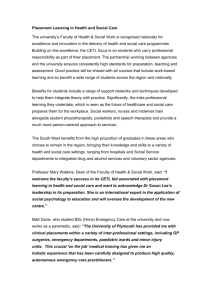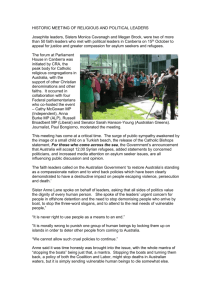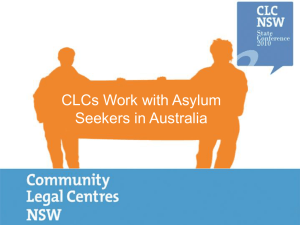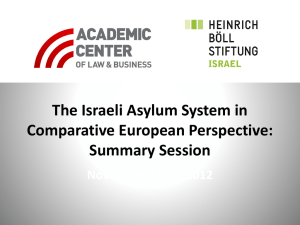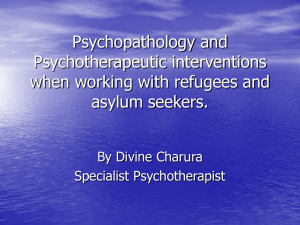The Israeli Asylum System: Contemporary Challenges in
advertisement
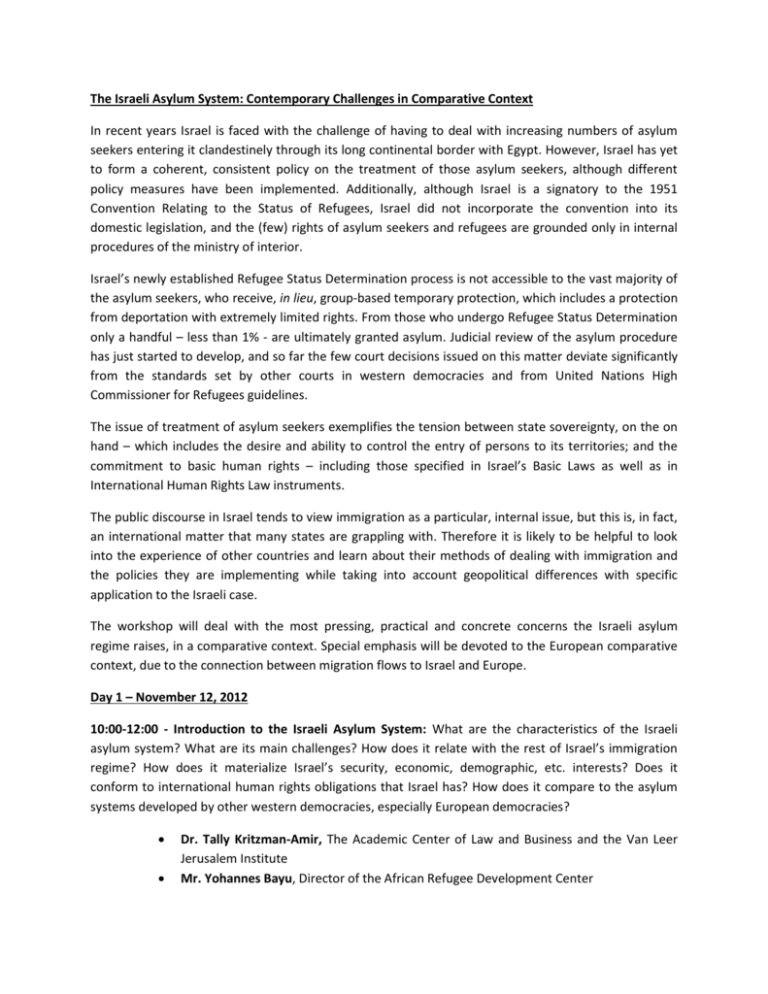
The Israeli Asylum System: Contemporary Challenges in Comparative Context In recent years Israel is faced with the challenge of having to deal with increasing numbers of asylum seekers entering it clandestinely through its long continental border with Egypt. However, Israel has yet to form a coherent, consistent policy on the treatment of those asylum seekers, although different policy measures have been implemented. Additionally, although Israel is a signatory to the 1951 Convention Relating to the Status of Refugees, Israel did not incorporate the convention into its domestic legislation, and the (few) rights of asylum seekers and refugees are grounded only in internal procedures of the ministry of interior. Israel’s newly established Refugee Status Determination process is not accessible to the vast majority of the asylum seekers, who receive, in lieu, group-based temporary protection, which includes a protection from deportation with extremely limited rights. From those who undergo Refugee Status Determination only a handful – less than 1% - are ultimately granted asylum. Judicial review of the asylum procedure has just started to develop, and so far the few court decisions issued on this matter deviate significantly from the standards set by other courts in western democracies and from United Nations High Commissioner for Refugees guidelines. The issue of treatment of asylum seekers exemplifies the tension between state sovereignty, on the on hand – which includes the desire and ability to control the entry of persons to its territories; and the commitment to basic human rights – including those specified in Israel’s Basic Laws as well as in International Human Rights Law instruments. The public discourse in Israel tends to view immigration as a particular, internal issue, but this is, in fact, an international matter that many states are grappling with. Therefore it is likely to be helpful to look into the experience of other countries and learn about their methods of dealing with immigration and the policies they are implementing while taking into account geopolitical differences with specific application to the Israeli case. The workshop will deal with the most pressing, practical and concrete concerns the Israeli asylum regime raises, in a comparative context. Special emphasis will be devoted to the European comparative context, due to the connection between migration flows to Israel and Europe. Day 1 – November 12, 2012 10:00-12:00 - Introduction to the Israeli Asylum System: What are the characteristics of the Israeli asylum system? What are its main challenges? How does it relate with the rest of Israel’s immigration regime? How does it materialize Israel’s security, economic, demographic, etc. interests? Does it conform to international human rights obligations that Israel has? How does it compare to the asylum systems developed by other western democracies, especially European democracies? Dr. Tally Kritzman-Amir, The Academic Center of Law and Business and the Van Leer Jerusalem Institute Mr. Yohannes Bayu, Director of the African Refugee Development Center Mr. William Tall, Representative of the UNHCR in Israel Adv. Avi Chimi, Chair of the Advising Committee on Refugees to the Minister of Interior Ms. Luise Amtsberg, The German Green Party 13:00-15:00 - Employment of Asylum Seekers: Despite the fact that the Internal Procedures of the Ministry of Interior on the Treatment of Asylum Seekers instruct that asylum seekers should be granted work permits, in practice, asylum seekers are only granted “conditional release” documents, which specifically forbid their employment. In HCJ 6312/10 Kav Laoved v. The Government of Israel the State of Israel made a commitment to refrain from enforcing the prohibition on the employment of asylum seekers, thus on the one hand refraining from granting them a right to work, but on the other hand turning a blind eye at those who employ them. This, in turn, resulted in asylum seekers having difficulties in finding employment, and relegating to undocumented employment, which commonly carries low salaries and no benefits. Should asylum seekers be allowed to work as they await a decision on their case? Does granting asylum seekers work permits raise the risk of a “pull factor” – that many others will come to Israel, and if so: can that risk be contained? What are the practical, economic and legal consequences of not granting them work permits? What are the alternatives? Did European states choose to grant asylum seekers work permits, or offer them in-kind assistance (in housing, food supplies etc.)? What, in their experience, are the benefits and dangers in each option? Dr. Yuval Livnat, Tel Aviv University School of Law Ms. Noa Kaufman, Coordinator of the Asylum Seekers and Refugees Subject, Kav Laoved Ms. Orit Rubin, Psyco-Social Coordinator, Assaf – Aid Organization for Refugees and Asylum Seekers in Israel Ms. Yael Dayan, Chair of Tel-Aviv City Council Prof. Audrey Macklin, University of Toronto School of Law Mr. Mulugeta Tumuzghi, Eritrean Asylum Seeker 15:30-17:30 - Detention of Asylum Seekers: In January 2012 the Israeli Parliament passed an amendment to the Prevention of Infiltration Law, allowing the prolonged detention of three years of those defined as infiltrators (and indefinite detention of enemy national infiltrators). Currently Israel is in the process of constructing what would be the biggest detention facility in the world for the purpose of the implementation of this law. Who would be held under this law? What goals does this law seek to promote? What are the moral and legal implications of the detention of asylum seekers? Is it legal to detain asylum seekers, and if so, under what conditions? How does this law conform to Israel’s constitutional law and international law obligations? How do these measures compare with those taken by other states in the world, including in Europe, such as off-shore detention etc.? According to the international experience, is detention an effective means of deterrence, and does a policy aiming to detain asylum seekers decrease the number of asylum seekers entering the state? Adv. Asaf Weitzen, The Hotline for Migrant Workers Adv. Ilan Halevgi, Immigration Detention Tribunal Prof. Kenneth Mann, Tel Aviv University School of Law Prof. Stacy Caplow, Brooklyn University School of Law Prof. Thomas Spijkerboer, VU Amsterdam University Mr. Bush Safallah, Drafurian Asylum Seeker Day 2 – November 13, 2012 9:00-11:00 - Temporary Protection and Other Forms of Complementary Protection: Protection as refugees is not the only solution available for asylum seekers in Israel. The vast majority of asylum seekers are from Eritrea and Sudan (nearly 65% and 25% respectively). Those asylum seekers are not granted access to the Refugee Status Determination process, but rather are granted group-based temporary protection, until the conditions in their country of origin sufficiently improve as to enable their return. In addition, asylum seekers may base their need for protection from being returned to their country on legal instruments other than the Convention relating to the Status of Refugees, such as the Convention against Torture and Other Cruel, Inhuman or Degrading Treatment or Punishment (CAT), or the International Covenant on Civil and Political Rights. This question became particularly relevant in the spring of 2012, when the temporary protection of Southern Sudanese was terminated, and the state conducted a massive operation, leading to their detention and deportation/voluntary repatriation. When should states offer temporary group-based protection? What is the difference between this form of protection and the protection granted to refugees? Should people who receive temporary protection be allowed to submit individual asylum applications? When should temporary group-based protection end; and how should those protected be treated when their protection comes to an end? What is the relationship between the different legal instruments offering protection to forced migrants? What can Israel learn from the use of the European Convention of Human Rights for the protection of refugees and people in refugee-like situations in European courts? What are the European norms on the application and termination of temporary protection regimes? Adv. Yonatan Berman, The Academic Center of Law and Business Prof. Michael Kagan, University of Nevada, Las Vegas Adv. Ohad Zemet, International Law Department, Ministry of Foreign Affairs Prof. Maryellen Fullerton, Brooklyn University School of Law Mr. Michael Kleinhaus, Head Asylum Affaires, Federal German Office for Migration and Refugees 11:30 – 13:30 - Erecting a fence on the Egyptian Border: The Israeli Government is currently in the process of planning and erecting a fence on the long continental border between Israel and Egypt, through which the overwhelming majority of asylum seekers enter Israel. This measure should be understood in light of the attempts of Israel to “return” to Egypt asylum seekers who were caught shortly after they crossed the border into Israel. These attempts that were challenged in the High Court of Justice (which refrained from ruling on the merits of the case, and dismissed the petition on procedural reasons), failed due to the changes in the Egyptian regime. What legal consequences does this fence entail? Will Israel be allowed to “fence out” its legal obligation to asylum seekers? Will it owe legal or moral obligations to people who present themselves on the other side of that fence, and if so, what is the scope of these obligations? What is the international experience with fences as means of restricting movements of asylum seekers? What can we learn from the Frontex experience of European Border control? Adv. Anat Ben Dor, Tel Aviv University School of Law Dr. Tally Kritzman-Amir, The Academic Center of Law and Business and the Van Leer Jerusalem Institute Dr. Eran Lerman, The Israeli National Security Council Mr. Peter Deck, UNHCR Mr. Christopher Hein, Italian Council for Refugees Mr. Mekonnen Mesghena, Head of Department for Migration, Intercultural Management & Diversity, Heinrich Böll Foundation 14:30-16:00 - Sur-place Refugees – Israel unique geopolitical situation reflects on the nature of claims the asylum seekers who enter it make. In some cases, asylum seekers claim that while they were not under risk of persecution in their country of origin before having fled from it, they are likely to be persecuted should they be returned from Israel to their country (and are therefore “sur-place refugees”). This argument is mostly (though not exclusively) made by Sudanese, whose country’s law penalize persons who enter Israel. Legally and morally speaking, sur-place refugees pose an interesting challenge to Israel’s asylum policy. Should we protect sur-place refugees? Under which conditions? Should the particular circumstances of Israel matter to the question of the protection of sur-place refugees? How are Sur-place refugees handled in Europe? Adv. Yonatan Berman, The Academic Center of Law and Business. State Official, TBA Prof. Thomas Spijkerboer, VU Amsterdam University Prof. Deborah Anker, Harvard Law School 16:30 – 17:30 – Summary Session
